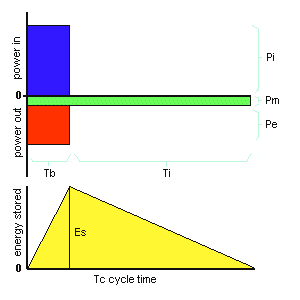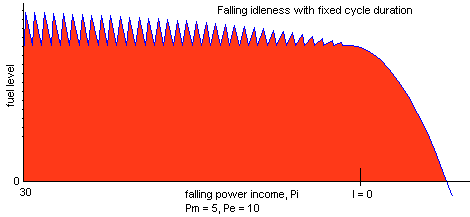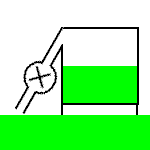
Life.
|
Two assumptions underlie the Idle Life model.
- The creatures are assumed to work continuously at maintaining or replacing their constituent components. This work is regarded as a continual background activity, the intensity of which depends upon the ease or severity of the environment in which these components exist - temperature, salinity, acidity, etc.
- The creatures work intermittently to acquire from their
environment the energy needed to power their maintenance work.
One argument for such intermittency lies in a the intermittent availability of energy in the environment: plants can only acquire solar energy during daylight hours, and many animals require daylight by which to find food.
Another argument is that even if energy is continuously available in the environment, the creatures are likely to be able to meet their energy requirements in a relatively short time.
Included in the assumption of intermittent work is an assumption that the creatures have a constant sustainable work rate. This is a simplification. But it reflects the important truth that, although creatures may be able to increase their work rates by an order of magnitude, they cannot sustain such work rates for long.
A further argument for intermittency is that if the creatures simply worked continuously, at whatever rate required, to acquire energy to power self-maintenance, they would have no need to store energy. But in the natural world, creatures typically maintain substantial energy stores, in the form of sugars, fats, starches.
 Given these assumptions, it is possible to write some simple equations:
Given these assumptions, it is possible to write some simple equations:
Assume some lifeform continuously works at a rate Pm repairing itself.
Assume that it is able to work at a rate Pe to acquire energy to power repair.
When it works to acquire energy, it acquires a power income of Pi. The power income, Pi, that the creature gets for its expenditures is dependent on the energy density of its environent. In an energy-rich environment, Pi will be larger than in an energy-poor environment.
At equilibrium, it alternates between being busy acquiring energy for Tb time, and being idle for Ti time, and its energy store level cycles between a maximum and a minimum.
At equilibrium, over unit time period, energy expended = energy received. And where I is Idleness or Ti/unit time,
| I = 1 - ( Pm / (Pi - Pe)) | ( 1 ) |
Given these assumptions, the Idleness of a lfeform is independent of the length of the cycle. It makes no difference whether it maintains its store at a high mean level, or allows its store to cycle more slowly from a high level to a low level.
The power consumption of this lifeform over the cycle is given by:
| (1 - I) . Pi | ( 4 ) |
Cycle Time
Plants will generally have cycle times of 24 hours or so. But more generally, the cycle time will reflect the intermittency in the availability of energy in the environment. Seasonal plants will need to be able to store enough energy in summer to last them through the winter.
Where energy is continuously available in the environment, cycle times are likely to fall to reflect this. Thus while a multicellular plant (e.g. an oak tree) may need to have a cycle time of a year, the individual cells in its energy-rich internal environment may need far shorter cycles.
For a fixed energy store Es, the duration of the cycle, Tc, is given by:
| Tc = Es / (I . Pm) | ( 2 ) |
And for a fixed length cycle, Tc, the energy stored Es is given by:
| Es = Tc . I . Pm | ( 3 ) |
When some lifeform has Pm = 5, Pe = 10, and Pi = 30, and a fixed length cycle, idleness is initially 75%. As Pi falls, idleness falls, and energy stored Es also falls. When I = 0, no energy is stored. And when calculated I < 0, actual idleness = 0, and the lifeform loses energy at a rate Pm + Pe - Pi.

The Apparent Busyness of Life
Living things are often thought of as being busy, and the busier they are, the more 'alive' they are. But from Idle Theory's perspective, these 'lively' animals are very likely to be the busiest ones, working to find energy in the environment. Most living things will live largely idle, 'do-nothing' lives, sleeping under rocks or in holes. Only the least idle will tend to be seen busily foraging for food. So the apparent busyness of life may only be a reflection of the fact that we humans tend to see only the busiest of living things. And these are often the smaller ones - like insects and birds - which have small energy stores which need to be frequently replenished.
Given that many predators (e.g. cats) use the movement of their prey to detect them, this suggests that many predators prey upon the busiest of the available range of lifeforms rather than the idlest - assuming that it is usual for idle lifeforms to remain motionless.
Plant Life.
Plants receive their power input from the sun, and they use chlorophyll to trap this energy and convert it into sugars (e.g. glucose or fructose) of one sort or other which are stored in the plant.
Solar energy is only available during the daytime, and so plants must capture all the energy they need during daylight hours, and remain idle during the night. This suggests that most plants will have an energy store of sufficient size for their cycle time to equal 24 hours.
Near the poles of the planet, the daytime is longer during the summer than it is in winter. If plants are unable to gain enough energy during the winter to stay alive, then they will have to store up enough energy during the summer to be able to idle through the winter, and they will need corresponding larger energy stores.
Assuming that the first plants were single cells, with a small energy store, the need for a 24-hour cycle (or, worse still, a 365 day cycle) would seem to have posed a considerable hurdle for life to overcome. Most prototype plant cells, with small energy stores, would have died at night or in winter.
This suggests that the earliest forms of life on earth were not plants, but some other life form which was powered by something other than solar energy, and which was continuously available. It was only later, when life was 'up and running' that it discovered a new source of energy in sunlight.

